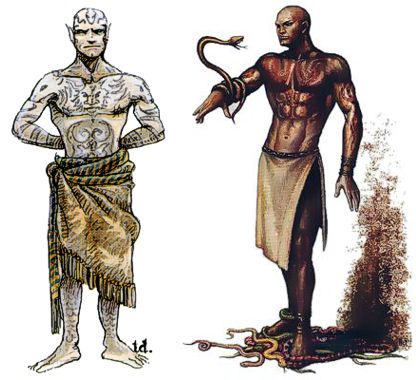

Monstrous Manual

| Maedar | Glyptar | |
|---|---|---|
| Maedar | Glyptar | |
| Climate/Terrain: | Subterranean | Any |
| Frequency: | Very rare | Very rare |
| Organization: | Solitary | Solitary |
| Activity Cycle: | Any | Any |
| Diet: | Carnivore | Not applicable |
| Intelligence: | Very (11-12) | Very (11-12) |
| Treasure: | P,Q(×10),X,Y | See below |
| Alignment: | Lawful Evil | Lawful evil |
| No. Appearing: | 1 | 1 |
| Armor Class: | 5 | 5 |
| Movement: | 9 | Fl 9 (A) |
| Hit Dice: | 6 | 1-4 hp |
| THAC0: | 15 | See below |
| No. of Attacks: | 2 | 1 |
| Damage/Attack: | 2-8/2-8 | 1 hp or by animated weapon |
| Special Attacks: | See below | Nil |
| Special Defenses: | See below | See below |
| Magic Resistance: | Nil | Nil |
| Size: | M (5-7’) | T (under 6”) |
| Morale: | Elite (13-14) | Elite (13-14) |
| XP Value: | 975 | 65 |
Maedar are male counterparts to medusae, though they lack the petrifying gaze of the females. The typical maedar is a muscular, hairless humanoid male, usually dressed in a kilt or tunic.
Combat: Maedar attack with powerful fists that each cause 2d4 points of damage. One every three turns, the maedar can turn stone to flesh by touch. Maedar can pass through stone at their normal movement rate. They require one round of concentration before this; no other activity can be undertaken that round. Maedar struck by a phase door spell while passing through stone are killed instantly.
Maedar are immune to petrification and paralyzation (including related spells, such as hold and slow). They are immune to the poisonous bite of a medusa’s serpentine hair. In addition, maedar can see into and extend their stone into flesh power into the Astral and Ethereal planes.
Habitat/Society: Maedar are the little-known male version of the medusae. They are extremely rare, however (far more rare than the frequency would indicate), and few medusae ever find a maedar spouse.
Most medusae typically mate with human males. This cross produces two to six eggs that hatch into fledgling, human-like females, who mature into medusae. The cross insures the continuation of the medusae species.
When a medusa finds and mates with the extremely rare maedar, the eggs hatch into human infants, 25% male and 75% female. Only 1% of the males born of these matings are actually maedar; the remaining males and all the females are normal human infants who die at the sight of their mother.
The typical maedar is a monogamist who mates for life; he is fiercely devoted to his mate and will go to any length to assist or avenge her. A widowed maedar will pursue his mate’s killer for years.
Because of the Maedar’s rarity and natural reclusiveness, even most sages are unaware of their existence. Maedar are rarely seen; generally they remain in the lair they share with a medusa mate. A maedar’s magical power provides food for him and his mate. He smashes her petrified victims, then transforms them into meat.
Ecology: Maedar may cooperate with lawful evil creatures, such as kobolds and orcs, in exchange for security or reward. If forced to aid another creature, maedar seek revenge at the first opportunity.
Glyptars are rock crystals animated by the spirits of maedar. When a maedar has foreknowledge of his death, he can transfer his life force into the rocks. An extremely evil maedar retains his consciousness as it drifts through the ground. When such a life force encounters gemstones, such as feldspar or amethyst, it is trapped within and cannot leave voluntarily. Eventually the maedar goes mad. (Note that once a maedar is trapped within a glyptar crystal, his life force cannot be trapped in a second crystal.)
If this glyptar is removed intact from the ground, the maedar’s spirit is now able to animate the crystal and anything inorganic attached to it. Thus if the glyptar is set in the eye of a stone statue, the maedar’s life force animates it as a golem. This can affect a maximum of 1,000 pounds.
Similarly, if the glyptar is set in the pommel of a sword, the sword can be animated to strike as though it were wielded by the living maedar. The weapon gains a +1 bonus to its attack roll, strikes as if it were wielded by a 6th-level fighter, and gains a +2 bonus to its damage roll. Note that the glyptar’s stone to flesh power enables the weapon to sink harmlessly into stone as the glyptar uses its power.
The glyptar retains its other powers as well. The glyptar and its attachments may pass through stone at will at the normal movement rate. It is immune to phase door spells. Once every three turns the glyptar can perform a stone to flesh attack against a target touched by the glyptar or its setting. Glyptars remain immune to paralyzation and petrification attacks of all sorts.
